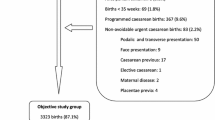Summary
The effects of obstetric intervention on newborns have been analysed. Forceps delivery leads to a high incidence of morbidity rate, facial palsy and intracranial injury. The outcome of the neonate is further modified by the indication forforceps application as well as associated factors like poor ante-natal care, poor socioeconemic status and parity of the mothers, which have been responsible for a high perinatal loss as compared to the controls. A high incidence of the respiratory distress syndrome was observed in caesarean babies as compared to babies delivered by the vaginal route. Internal podalic version was hazardous to the neonate. Leading to greater proclivity to asphyxiation, still-birth and higher perinatal loss.
Similar content being viewed by others
References
Acken, H.S. and Brooklyn, N.V. (1932). Report of 535 consecutive cases of mid and high forceps.Am. J. Obst. and Gynec. 23, 538.
Apgar, Virgina (1966). The Newborn-Apgar scoring system.Paed. Clin. North Amer. 13, 645.
Assali and Zachariasis (1947). Foetal and maternal mortality-11 years survey.Am. J. Obst. and Gynev. 54, 651.
Bhargava, R. (1967). Forceps delivery. Thesis submitted for M.S. Degree to the University of Rajasthan.
Butler, N.R.; and Alberman, E.D. (1969). Perinatal problems.E. & S. Livingstone. Edinburgh and London.
Denen, E.H. (1952). Classification of forceps operations.Am. J. Obst. and Gynec. 63, 272.
Devi, P.K. (1960). A review of forceps deliveries over a five year period.J. Obst. and Gynec India. 9–10, 108.
Erhardt, C.L. and Gold, E.M. (1958). Caesarean section in New York city-Incidence and mortality during 1954–55.Obst. and Gynec. 11, 241.
Flemming and Morton (1930). Quoted by Nesbitt.
Moir, J.C. and Myercough, P.R. (1972). Munrokerr Operative Obstetrics. 8th Edition, London,Bailliere, Tindall and Cox.
Nesbitt, L.E.R. (1957). Perinatal loss in modern Obstetrics.F A. Davis Company, Philadelphia.
Pedvis, S. (1949). Infant mortality in caesarean section.Surg. Obst. and Gynec. 88, 103.
Percival, R. (1959). Holland and Brews Manual of Obstetrics. 8th ed.J.A. Churchii, London.
Posner, C.A.; Cohn, S. and Posner, N.S. (1954). Caesarean section progressive trends—A review of 852 cases.Am. J. Obst. and Gyne. 67, 66.
Sarojini, T. (1961). Perinatal mortality in forceps operations in King George Hospital—Vishakapatnam.J. Obst. and Gyne. 12: 186.
Schaffer, G. and Carpenter (1953). Caesarean section.Obst. and Gynec. 2, 535.
Usher, R. (1961). Respiratory distress syndroma of prematurity.Pediat. Clin. North Amer. 8, 525.
Vaux, N.W. (1930). The methods of delivery and the results of 212 cases of occipito-posterior position.Am. J. Obst. and Gynec. 20, 782.
Author information
Authors and Affiliations
Additional information
From the Department of Pediatrics, S.M.S. Medical College, Jaipur.
Rights and permissions
About this article
Cite this article
Sharma, U., Idnani, N. & Saxena, S. Effects of obstetrical interference on the newborn. Indian J Pediatr 45, 143–153 (1978). https://doi.org/10.1007/BF02758225
Received:
Issue Date:
DOI: https://doi.org/10.1007/BF02758225




